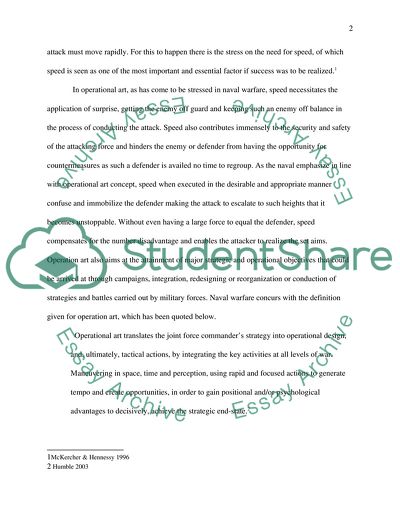Cite this document
(The US Experience in the Pacific and Battle of Leyte Essay Example | Topics and Well Written Essays - 1250 words, n.d.)
The US Experience in the Pacific and Battle of Leyte Essay Example | Topics and Well Written Essays - 1250 words. https://studentshare.org/military/1753007-does-the-concept-of-operational-art-apply-to-naval-warfare-how-is-the-us-navy-experience-in-the-pacific-and-the-battle-of-leyte-gulf-in-particular-relevant-to-your-conclusions
The US Experience in the Pacific and Battle of Leyte Essay Example | Topics and Well Written Essays - 1250 words. https://studentshare.org/military/1753007-does-the-concept-of-operational-art-apply-to-naval-warfare-how-is-the-us-navy-experience-in-the-pacific-and-the-battle-of-leyte-gulf-in-particular-relevant-to-your-conclusions
(The US Experience in the Pacific and Battle of Leyte Essay Example | Topics and Well Written Essays - 1250 Words)
The US Experience in the Pacific and Battle of Leyte Essay Example | Topics and Well Written Essays - 1250 Words. https://studentshare.org/military/1753007-does-the-concept-of-operational-art-apply-to-naval-warfare-how-is-the-us-navy-experience-in-the-pacific-and-the-battle-of-leyte-gulf-in-particular-relevant-to-your-conclusions.
The US Experience in the Pacific and Battle of Leyte Essay Example | Topics and Well Written Essays - 1250 Words. https://studentshare.org/military/1753007-does-the-concept-of-operational-art-apply-to-naval-warfare-how-is-the-us-navy-experience-in-the-pacific-and-the-battle-of-leyte-gulf-in-particular-relevant-to-your-conclusions.
“The US Experience in the Pacific and Battle of Leyte Essay Example | Topics and Well Written Essays - 1250 Words”. https://studentshare.org/military/1753007-does-the-concept-of-operational-art-apply-to-naval-warfare-how-is-the-us-navy-experience-in-the-pacific-and-the-battle-of-leyte-gulf-in-particular-relevant-to-your-conclusions.


